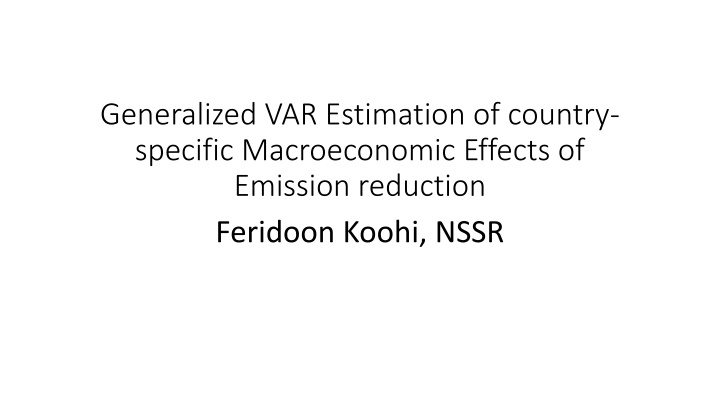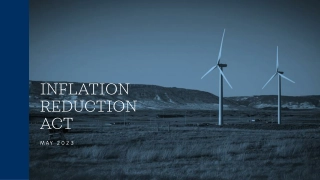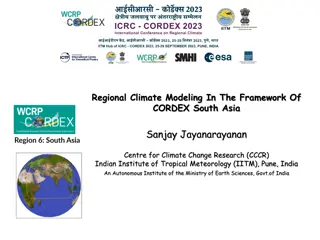
Country-Specific Macroeconomic Effects of Emission Reduction: VAR Estimation
Explore the impact of carbon tax policies on future emissions, employment, and growth with a focus on the double dividend hypothesis. Delve into the potential of fiscal policies and green financing in achieving environmentally sustainable outcomes through a budget-neutral approach. Understand the conditions influencing the effectiveness of carbon taxation in different countries.
Download Presentation

Please find below an Image/Link to download the presentation.
The content on the website is provided AS IS for your information and personal use only. It may not be sold, licensed, or shared on other websites without obtaining consent from the author. If you encounter any issues during the download, it is possible that the publisher has removed the file from their server.
You are allowed to download the files provided on this website for personal or commercial use, subject to the condition that they are used lawfully. All files are the property of their respective owners.
The content on the website is provided AS IS for your information and personal use only. It may not be sold, licensed, or shared on other websites without obtaining consent from the author.
E N D
Presentation Transcript
Generalized VAR Estimation of country- specific Macroeconomic Effects of Emission reduction Feridoon Koohi, NSSR
Main questions Double Dividend Hypothesis: Can Carbon tax policy uncertain (hard to measure) reduce future mission and increase or keep constant its certain current employment and growth effects ? This question is addressed by two major policy tools:, fiscal policy based on carbon taxation and monetary policy based on green bond returns. This presentation examines the Macroeconomic modeling effectiveness of carbon taxation, though much I have to say is also applicable to green financing public policy.
Main questions The answer to that question requires measuring whether the gross cost of carbon tax effects to those who currently over-emit will be negative or at least zero regardless of its negative net cost benefits in terms of reduced CO2 omission. A budget-neutral carbon tax (tax high omission sectors and distribute the exact amount as subsides to low omission sectors) has been extensively discussed as a policy tool that can successfully promote a double-dividend outcomes . Some generally agreed conditions point out to the importance of country-specific differences that determine the outcome of fiscal carbon tax policy.
Main questions Generally, the extend of the effectiveness of DD benefits depends on the already existing tax system of an economy; (Gould, 1995b) points out o four conditions: a) if the difference in the marginal efficiency costs (marginal excess burdens) is large b)The burden of the environmental tax falls primarily on the factor with relatively low marginal efficiency cost c) the base of the environmental tax is relatively broad , so that the distortions it generates are small d)the tax revenues are devoted to reducing tax rates on the factors with relatively high marginal efficiency cost.
Main questions OECD (2004) has points out the status of the labor market: with involuntary unemployment, employment will only increase if the use of environmental taxes to partially replace existing taxes results in an increased demand for labor. If the labor market is in equilibrium, additional employment could only be caused by increasing labor supply. Such information may be available at a country-level study, including them in the global modeling of inter-country effects would involve a huge number of parameter estimates; in any case the data unlikely to available, hence the necessary of threating such differences as unobservable.
Main Questions OECD (2004) has points out the status of the labor market: with involuntary unemployment, employment will only increase if the use of environmental taxes to partially replace existing taxes results in an increased demand for labor. If the labor market is in equilibrium, additional employment could only be caused by increasing labor supply. Such information may be available at a country-level study, including them in the global modeling of inter-country effects would involve a huge number of parameter estimates; inefficient and infeasible approach. In any case the data unlikely to available, hence the necessary of threating such differences as unobservable in modeling macroeconomics of climate tax public policy.
VAR model of Emission Reduction Effects We focus on the short-term employment dynamics that could be triggered by a carbon tax on high-carbon intensive sector, ignoring long-term technical change. In particular, we are interested in the effects of a budget- neutral carbon tax scheme in which the collected tax revenue is reinjected into the economy. We assume that tax increases lead to negative growth and employment while subsidies to low carbon sector obtains positive ones. We note that the employment effects of budget-neutral tax policy have controversial; Anderson and Ekins (2009) and Ekins and Speck (2011) provide recent evidence on economic effects of environmental tax reforms in European countries.
VAR model of Emission Reduction Effects We model the country-specific interactive effects by dividing economic into high and low CO2 intensive sectors. One approach to follow is that of Kato el. al. (2014) that rank industries in all countries identical basis on the German CO2-intensity data as a two-sector industry ,HCIS and LCIS, classification., using on the German input-output data of 2005 as the base. The implication is that the HCIS-LCIS turning point is the same across all economies , thus rendering one source of country-specific differences irrelevant; others remain.
VAR model of Emission Reduction Effects We start with Kato et. al. (2014) first-order, four-variable VAR model , expressed in annual growth rates (lag-differences) by for employment EMP) and growth (OUT) as ??? ?,? ?????,? ??? ?,? ?????,? ????????,? ?????? ?,? 1 We note that (1) estimates each country effects on others , excluding the emission ploy interactive impacts on the country-specific estimates . There are different ways o improve on (1) in that respect, here we examine the Generalized Vector Autoregression (GVAR) approach to that problem . ?????? ?,? ?????? ?,? 1 ????????,? ????????,? 1 ?????? ?,? ?????? ?,? 1??= = x100 (1)
GVAR countryspecific Emission Reduction Effects GVAR methodology applies to context of a large number of macro units (countries) , globally or a broad regions, all influenced by each other, hence assumes all country specific are endogenous. As in (1) var model, each country in the GVAR model has autoregressive domestic regressors, but the interactive effects are included in each equation of the VAR model by a so called star variable. The star variables take into account the impact of the rest of the world on tin each country AR equation by a weighted extend of that country s economic interaction in with the world economy.
GVAR countryspecific Emission Reduction Effects Similar to a four-sector (1) VR model , teach country s EMP and OUT in the rest of the world is weighted by its share of impact, and the weights are based on either trade (extend of import and export) or capital flows.; these are the foreign variables , or star variables of GVAR. The dimensionality problem in GVAR is resolved by the employment of dimension reducing methods, two approaches standard in the literature are principal component analysis and common factor analysis; both apply when working with big data Both procedures are employed in order to educe a large number of parameter estimates to a few.
GVAR countryspecific Emission Reduction Effects The P C seeks to obtain the maximum variance for a large number of variables as measures of their joint variation.; the first PC captures the largest joint variation, typically at least 50%, usually more that 60%; what is left is then captured by the second amount f joint variation exclude from the first , and thus, added as a second variable that is therefore orthogonal to the first,; the same with the third PC if necessary, etc. The PC is often employed in the Lasso econometrics dealing with big data modeling, and studies show that the first few PCs, often just the first, can capture the joint variation for a large number of related variables., see Stack and Watson (2004?)
GVAR countryspecific Emission Reduction Effects The common factor method selects a common variable list from a two-step procedure with first stage joint estimation of each country equation by a SURE-type of estimator, that are then used to obtain a common factor of all micro variables in the second stage. (SAY MORE) GVAR can then model country-specific interactive effects of a global CO2 emission model by a few domestic and star (foreign) variables that take the macroeconomic modeling of CO2 emission beyond (1), therefore addressing interactive effects of county heterogeneity. It is an appropriate approach when modeling is to a broad region, e.g. Sub-Sahara Africa, The EU, Latin America, the Middle East, or the world economy context of global climate change.
GVAR countryspecific Emission Reduction Effects GVARX applications are based on relatively large cross-section units i=1, 2, . . . N and large time- series t=0, 1, 2, . . . T. However, the number of country-specific variables k are small and divided into domestic variables affected only country i and the rest of the world (or region) foreign variables that condition the effects of the domestic variables on the outcome of interest. GVAR introduced by Pesaran et. al. (2004) estimate the world economic effects of the Asian Financial Crisis of 1997, offers a solution to the modeling f interdependence variables across N countries requiring estimating a large number of coefficients, without eroding estimation efficiency. This method still faces an identification problem if the interest is in obtaining coefficient estimate for the marginal effect of each regressor. However, forecasting and impulse response analysis can still be conducted with a few factor loadings for foreign variables because individual parameter identification is not required for implementing such tasks. This explains why the GVAR model is usually employed for forecasting or impulse response analysis because the method sidesteps the inference estimation, though GVAR for that step is also possible by semi-parametrically.
GVAR countryspecific Emission Reduction Effects GVAR employs the linear combination of tactor augmented regression model to obtain parsimonious models. Modifying (1) for GVAR suggests ?????,?,?= ??????,?,? ?+ ??,?0?????,?? ?????,?,?= ??????,?,? ?+ ??,?0?????,?? Where ??????or??????=vector of domestic variables; ?????? weighted foreign variables, t=0, 1, 2 T and outJ=high and low carbon industry output; similarly (1) with empJ=high and low carbon industry employment. To apply (2)-(3), we use trade weights for foreign star variables; initially with a univariate formulation as in (1) with domestic lag variables ??=1 and k=1 also , but star variables ?? 1. Not all the variables need to be included in each country-specific VAR model, but as discussed in the appendix below, the GVARX* allows for such country differences in lagged variables. +??,???????,?,? ? +??,???????,?,? ? + ?? (2) (3) + ?? ?? ?????? =vector of
GVAR countryspecific Emission Reduction Effects To apply (2)-(3) we use trade weights for foreign star variables; initially with a univariate formulation as in (1) with domestic lag variables ??=1 and k=1 also , but star variables ?? 1. Not all the variables need to be included in each country- specific VAR model, but as discussed in the appendix below, the GVARX* allows for such country differences in lagged variables. Hebous and Zimmermann (2013) is an example of GVAR application to the fiscal policy shock of one EU country on the rest, while Cashin, Mohaddes, and Raissi (2014) investigate macroeconomic impacts of weather shocks on economic activity.
Data Sets and Trade weights We employ data for employment and output from he EU-KLEM S data base http://www.euklems.net/index.html, O; Mahony and Timmer (2002) on how the KLEMS data base is constructed .However, the countries data sets employed in Kato el. al. (2014) cover shorter of 1995-2011 but larger number of nine countries. Growth (GO_PYP) and employment (EMP) data are pulled from KLEMS for Germany, France, Hungary, Japan, and Sweden. Neither Australia nor South Korea were present in the data. GO_PYP was not available for either the USA or the UK. Additionally, EMP was not available for the USA.
Data Sets and Trade weights Data was collected from 1995 to 2018. 1994 and 2019 were also available but contained missing data, and so were dropped. Weight matrices were constructed using WITS data. Matrices were constructed for each year, yielding 23 matrices total. An average weight matrix was also constructed. Because we include both HCI and LCI variants for each country, the weight matrices must also incorporate both variants. Because we use countries to construct weights, the weights for HCI and LCI are the same. This results in two identical rows for each country, one for HCI and one for LCI. To ensure that rows sum to 1, all values are divided by 2. Attached are the cleaned datasets I used to run the GVAR model. matrix_0 corresponds to the trade weight matrix for 1995 and matrix_22 corresponds to the trade weight matrix for 2018.
Table 1_ Lag structure of the model Country lags 1 France_HCI 1 2 France_LCI 1 3 Germany_HCI 1 4 Germany_LCI 2 5 Hungary_HCI 2 6 Hungary_LCI 2 7 Japan_HCI 1 8 Japan_LCI 1 9 Sweden_HCI 2 10 Sweden_LCI 2
Some illustrative GVAR Estimates Table 1 shows the number of lags , and table 2 ethe GVAR values; each column of the table represents the estimates for either EMP or OUT autoregressive terms and they differ in the number of lags (maximum of lags) is two). We note that lag structure is based on AIC , and model selection also leads to different lags for each country, and with each country, e.g. Germany,. Tall he star variables have a contemporaneous and first lag term. Table 2 GVAR estimates shown for our small sample of five countries ; they intend to demonstrate an example of GVAR application rather than reliable values for a macroeconomic climate We note that GVAR application usually attempt to provide generalized Impulse- response function analysis rather than inference estimation; however, AGVR inference outcome is a first step into GIRF and for that reason GVAR estimation has to be undertaken even if GIRF is the main research interest .
Some illustrative GVAR Estimates As shown in (2)-(3), the star variables have a contemporaneous and afirst lag specification as selected by AIC. We hesitant to enter a detail discussion of the estimates here.; a board patten should be note.. Almost all he large regressor effects are contained in the lower section of the table representing the star estimates . The star coefficient estimates are far larger than AR coefficients ; AR parameter for Sweden being an exception The star values tend to be larger for low compared to high CO2 industries . The exception is Hungry that appears to have very small estimates for AR and star parameters.






















